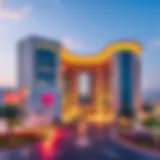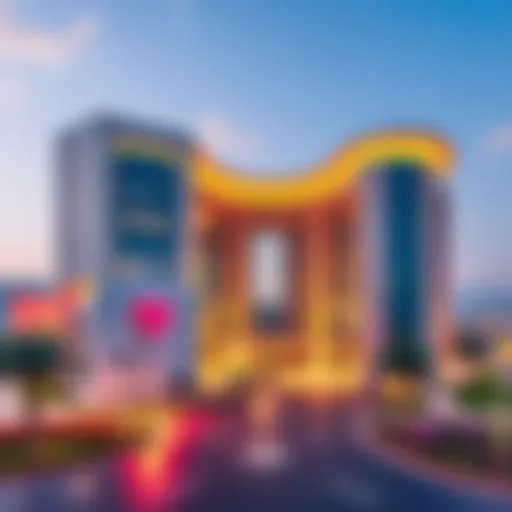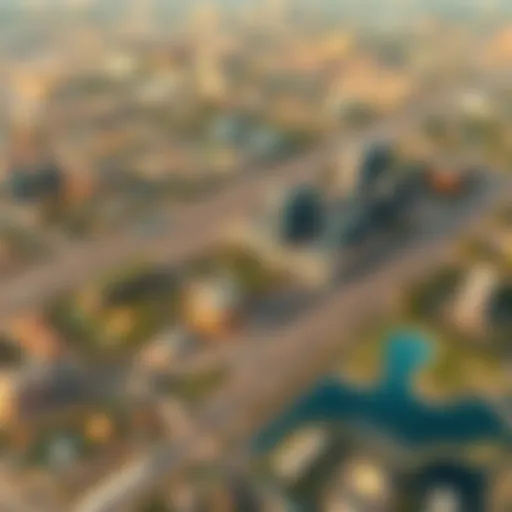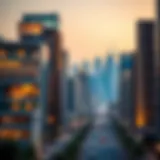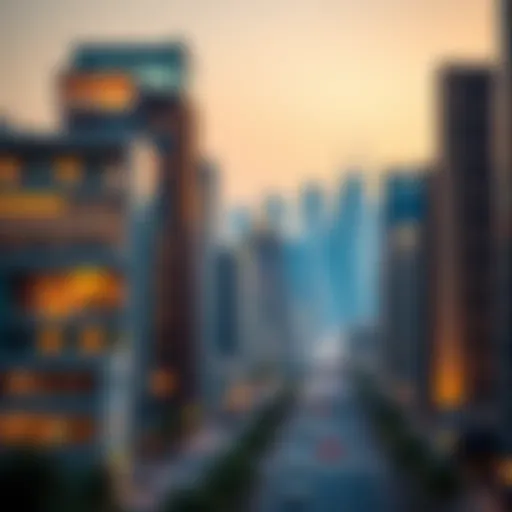Explore the Unique Residential Areas of Dubai
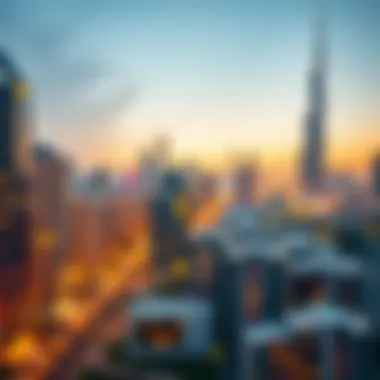
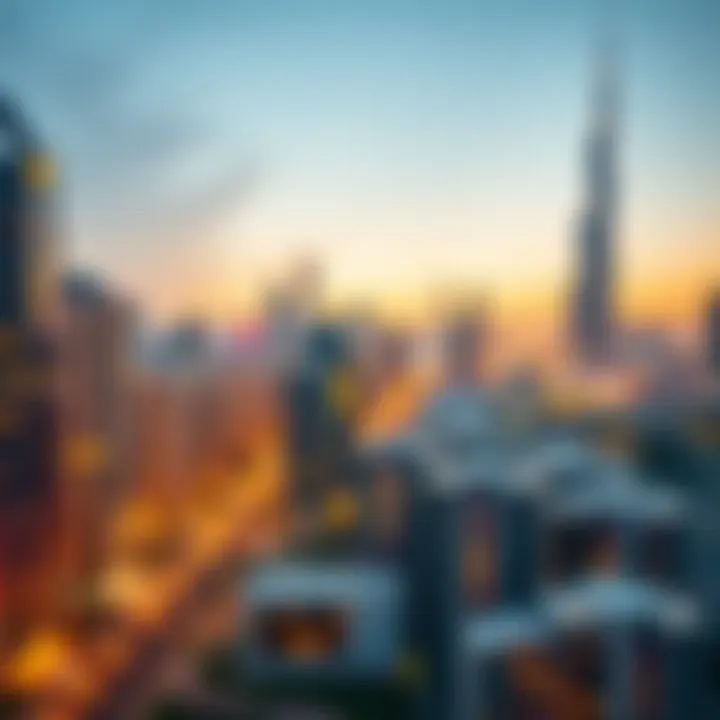
Intro
Dubai, a shimmering metropolis nestled in the heart of the Arabian Peninsula, offers a unique tapestry of residential neighborhoods each with its own story to tell. This city isn't just a bustling hub for tourism and commerce; it's also a vibrant home to people from all corners of the globe. Understanding the residential areas in Dubai requires delving into their distinct characteristics, community vibes, and lifestyle offerings.
As we explore the neighborhoods, we will uncover features that make each one inviting, from their lush landscapes to architectural marvels. Moreover, we'll dive into the daily lives within these communities, examining local events, lifestyle amenities, and the spirit of what it means to live in this ever-evolving landscape. This exploration is essential for homeowners looking to find their perfect oasis, visitors wanting to immerse themselves in the local culture, and urban planners hoping to shape Dubai's future.
In essence, our journey will equip you with a nuanced understanding of what makes each residential area in Dubai not just a place to live, but a community brimming with possibilities.
Neighborhood Features
Landscaping Highlights
Dubai’s residential neighborhoods boast enchanting landscapes that contribute to a sense of calm and community. Parks and green spaces play a vital role in enhancing quality of life. For instance, consider the massive Al Barsha Park, which stands as a green oasis amidst the urban sprawl. This lush expanse offers cycling paths, playgrounds, and serene picnic spots, providing families with a retreat from the city's fast pace.
Another noteworthy area is Jumeirah, known for its well-manicured gardens and palm-lined streets. It's a sight to behold when you stroll through these neighborhoods, taking in the colorful flowers and verdant trees. The strategic planting not only beautifies the area but also helps combat the heat, creating a cooler atmosphere for residents and visitors.
Architectural Styles
The architecture in Dubai’s residential areas is as diverse as its population. From traditional Arabian designs to sleek modern structures, the city paints a picture of evolution. In neighborhoods like Al Fahidi, charming wind-tower buildings remind visitors of the emirate's historic past. These structures were ingeniously designed to channel natural breezes into homes, merging aesthetics with practicality.
Conversely, in more contemporary areas such as Dubai Marina and Downtown Dubai, the skyline showcases towering skyscrapers and bold designs. The Burj Khalifa, the world’s tallest building, is a prime example, representing the heights of luxury living combined with groundbreaking engineering. Each architectural style carries its own narrative, reflecting the cultural confluence that defines Dubai today.
Community Life
Local Events and Activities
Community life in Dubai is rich and varied, catering to all tastes and preferences. With events and festivals happening year-round, there's always something to look forward to. For instance, the Dubai Shopping Festival not only attracts shopaholics but also locals who partake in celebrations, food stalls, and live entertainment.
In addition, many neighborhoods host their own cultural events that foster community spirit. In Al Quoz, art exhibitions and open studio events showcase local talent, allowing residents to engage with artists and craftspeople. This sense of participation is vital to forging connections and nurturing community bonds.
Lifestyle Amenities
Every neighborhood in Dubai comes equipped with lifestyle amenities that cater to the residents' comfort and convenience. Take, for instance, the upscale developments in Palm Jumeirah, which offer high-end shopping, gourmet dining, and luxury spas right at one's doorstep. These amenities are designed to make life not just livable but enjoyable.
In districts such as Jumeirah Lake Towers, the integration of retail outlets, fitness centers, and public transport options demonstrates a commitment to convenience and accessibility. The fusion of residential living with commercial offerings creates a dynamic lifestyle that appeals to many.
"Understanding the unique aspects of each neighborhood can transform the experience of living in Dubai from ordinary to extraordinary."
Foreword to Residential Areas in Dubai
Understanding the residential areas in Dubai is like peeling back an onion—each layer reveals something distinct about the lifestyle, culture, and community that exists within this flamboyant city. The significance of exploring these neighborhoods cannot be overstated. This article aims to provide practical insights for homeowners, visitors, urban planners, and architects to navigate the multifaceted landscape of Dubai's residential offerings. Each area has its own character, history, and myriad of services that cater to various lifestyles.
The Context of Real Estate Development
The residential scene in Dubai is not just a byproduct of urban growth but is shaped by strategic planning and economic tides. Over the last few decades, this city has become a beacon for both local and international investors. With a diverse demographic, there's an increasing demand for varied housing types; from opulent villas in gated communities to high-rise apartments overlooking stunning waterfronts. This variation stems from the broad community needs, fueled by the influx of expatriates and the growing local population.
Moreover, government initiatives such as the Dubai 2040 Urban Master Plan emphasize sustainable growth, encouraging developers to prioritize environmentally friendly construction and zoning. The shift towards mixed-use development is also prominent—where residential spaces coexist harmoniously with commercial sectors, parks, and recreation areas.
Diversity in Housing Options
Diversity is the name of the game when it comes to housing options in Dubai. Each neighborhood offers its own unique flavor, appealing to different tastes and budgets. Here are some noteworthy options:
- Apartments: High-rise buildings in bustling areas like the Dubai Marina offer a modern, urban lifestyle, complete with jaw-dropping views and amenities.
- Villas: In family-centric communities like Arabian Ranches, spacious villas with rich landscaping and community parks create a nurturing environment.
- Townhouses: Projects in areas like Jumeirah provide a blend of style and practicality, suited for smaller families or professionals seeking homeownership.
This variety allows potential residents to find a space that resonates with their personal preferences, lifestyle needs, and financial capabilities. Thus, whether one is a young professional heading for a studio in Business Bay or a family looking for a sprawling villa in Palm Jumeirah, Dubai’s residential areas cater to every craving.
Key Residential Districts Overview
Understanding the major residential districts in Dubai provides valuable insights into the city's vibrant lifestyle and urban planning. Each district possesses distinct characteristics, allowing potential residents and investors to consider which area aligns with their personal or professional needs. The blend of luxury, tradition, and modern living found in Dubai’s neighborhoods caters to a variety of lifestyles and preferences. Evaluating residential districts is essential for grasping how they contribute to the overall dynamism of Dubai, making it vital for homeowners, visitors, and urban planners alike.
Downtown Dubai
Architectural Landmarks
The architectural marvels of Downtown Dubai serve as a pivotal point in the city’s identity. The Burj Khalifa, standing tall as the world's tallest building, anchors this neighborhood and draws both tourists and potential residents. The design incorporates modern aesthetics with cultural influences, giving a nod to Islamic architecture.
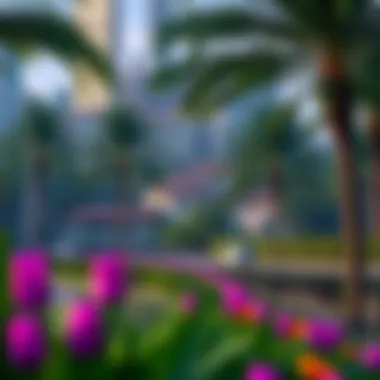
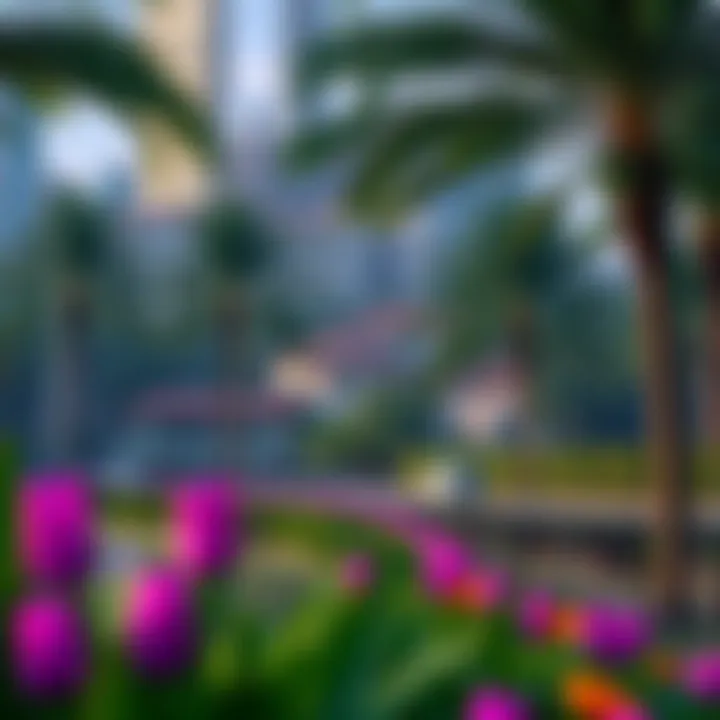
This area boasts intricate facades and cutting-edge designs, creating a skyline that captivates onlookers. Living in Downtown means being surrounded by landmarks like the Dubai Mall and the Dubai Fountain, spaces that enhance the appeal of urban life. However, the bustling atmosphere can be overwhelming for some, and the cost of living is another high point to consider.
Cultural Significance
Downtown Dubai is more than just a collection of tall buildings; it’s rich with cultural meaning. The area is known for its blend of modernity and tradition, with art installations and cultural events that reflect the diverse tapestry of the city. The Dubai Opera, for example, brings a cultural vibrancy that is unparalleled in many other districts.
This cultural essence attracts those seeking not just a home, but a lifestyle filled with artistry and performances—a beneficial aspect for residents who appreciate live events. Nonetheless, the constant evolution of the area can lead to a feeling of impermanence.
Dubai Marina
Waterfront Living
Dubai Marina epitomizes the essence of waterfront living, offering luxurious towers that line the stunning coastline. With a vibrant nightlife, excellent dining, and a picturesque marina, this district appeals to young professionals and families alike. The lifestyle of waking up to views of the water can’t be understated; it’s an experience that adds immense value.
However, potential residents should be mindful of high rental prices, given the coveted nature of this area. Access to water sports and beach activities is a huge plus for families looking to blend leisure with everyday living.
Leisure Facilities
The plethora of leisure facilities in Dubai Marina enhances its desirability. Residents enjoy pristine beaches, well-equipped gyms, and multiple pools—the conveniences that make daily life enjoyable. Moreover, the Marina Walk offers a scenic promenade filled with restaurants and shops, fostering a sense of community.
Such facilities cater to a lifestyle that emphasizes wellness and relaxation. On the flip side, the popular nature of these amenities can mean crowded spaces during peak hours, which may deter those looking for tranquility in their living environment.
Jumeirah
Beachfront Access
Jumeirah is famed for its beachfront access, presenting an idyllic setting for sun-seekers and beach lovers. The shores of the Arabian Gulf welcome residents to bask in the sun or engage in water sports. Living here can feel like a perpetual vacation, which is a major draw for many.
While this area offers ample recreational hotspots, it's essential to note that beachfront living comes with challenges, such as higher living expenses and, in some spots, noise from tourist activities.
Community Features
In terms of community features, Jumeirah boasts a range of amenities like schools, healthcare facilities, and parks. This aspect supports families seeking a holistic living experience. The established community is welcoming and offers various services that cater to everyday needs and enhance communal life.
Yet, while it’s family-oriented, newcomers may find some parts lacking in diversity in shops and cafes, potentially making it less appealing for those looking for a bustling, urban lifestyle.
Arabian Ranches
Family-Friendly Community
Arabian Ranches is recognized for its family-friendly environment, designed with spacious villas and community-centric amenities. The layout promotes outdoor activities with playgrounds and walking trails that invite families to bond and engage in recreational pursuits.
This area attracts families looking for a peaceful residential space away from the city's hustle but within reach of essential services. However, the challenge can be commuting—being distanced from the city center might not suit everyone.
Open Spaces
The open spaces available in Arabian Ranches add to its charm. Parks are well-maintained, and dedicated areas for activities promote a balanced lifestyle. Homeowners can enjoy picnics, jogs, or just unwinding amidst nature.
This prioritization of green spaces softens the urban experience, making it inviting. On the downside, lack of nearby shopping options could require residents to travel farther for some conveniences, which may be less appealing for some.
Palm Jumeirah
Iconic Design
Palm Jumeirah, with its unprecedented palm-shaped design, is a real testament to innovative thinking in urban development. The unique architectonic style sets this residential area apart from others, becoming not just a locale but a coveted landmark.
This distinctive layout showcases luxury villas and hotels, attracting affluent residents and investors. Nevertheless, the allure of exclusivity often brings along a price tag that may be prohibitive for many.
Exclusive Living
Living in Palm Jumeirah can be seen as exclusive, defined by high-end amenities, private beaches, and luxurious properties. This area’s identity revolves around sophistication and high-class lifestyle, which contributes significantly to its appeal.
Such exclusivity creates privacy and a sense of safety, but it can also foster an environment that feels disconnected from the authentic local culture.
Business Bay
Commercial and Residential Blend
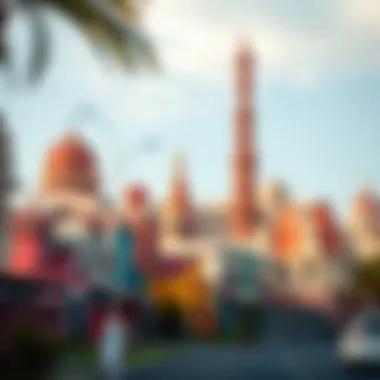
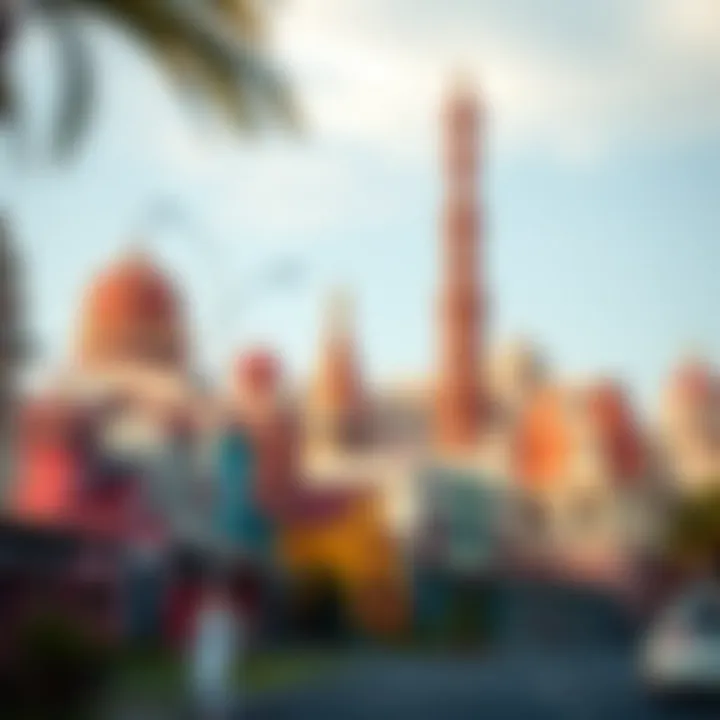
Business Bay serves as a vibrant hub where commercial and residential sectors intertwine seamlessly. The skyscrapers create a buzzing atmosphere conducive to work and leisure, attracting professionals who appreciate the convenience of living where they work.
This blend is advantageous for those in fast-paced jobs who prefer a short commute. However, the high energy can be overwhelming, possibly turning away those who desire a more tranquil neighborhood.
Proximity to Key Attractions
Being near major attractions such as the Burj Khalifa and Downtown Dubai enriches the living experience in Business Bay. The accessibility to various dining and shopping options makes it a compelling choice for many expatriates and professionals.
Nevertheless, this immediacy can also lead to increased traffic congestion, which may detract from the overall appeal as some may prefer quieter living conditions.
With each district representing a different facet of Dubai’s diverse identity, prospective residents can find space that resonates with their lifestyle preferences and aspirations.
Architectural Styles and Trends
The architectural landscape of Dubai is not merely a backdrop but a crucial component that reflects the city's cultural heritage and modern aspirations. The styles and designs found throughout its residential areas serve as a testament to the Emirate's transformation from a modest fishing village to a global metropolis. Recognizing and understanding these architectural elements is essential for homeowners, visitors, and urban planners alike. They provide insights into the livability, aesthetic appeal, and market value of different neighborhoods. Moreover, architectural trends showcase the integration of functionality with innovative design, resulting in unique living environments that are both appealing and practical.
Contemporary Designs
Contemporary architecture in Dubai represents the cutting edge of design, focusing on innovative forms and sustainable practices. Buildings in this style often feature sleek lines, glass facades, and open spaces that invite natural light to permeate interiors. Notable examples can be spotted in areas like Dubai Marina, where towers climb high into the sky, seemingly dancing with reflections of the water below.
Characteristics of contemporary designs include:
- Sustainability: Many recent projects emphasize eco-friendliness by incorporating renewable energy sources and materials with low environmental impact.
- Technology Integration: Smart homes are becoming prevalent, outfitted with state-of-the-art automation systems that enhance comfort and security.
- Minimalism: The focus is often on simplicity and functionality, avoiding excessive ornamentation to create uncluttered, calming spaces.
Understanding these trends shapes how buyers and renters perceive value. For instance, properties with eco-friendly certifications or smart technology may command higher prices. This shift in design philosophy not only enhances aesthetic appeal but also fosters a community spirit by encouraging the use of shared spaces and amenities.
Traditional Influences
While contemporary designs dominate much of Dubai's skyline, traditional architectural influences remain significant, often providing a sense of identity and continuity amid rapid development. These designs echo the UAE's rich cultural history and Bedouin heritage, celebrating local craftsmanship and materials.
Key elements of traditional architecture in Dubai include:
- Wind Towers (Barjeel): These ancient structures serve as natural ventilation systems, cooling homes without the use of air conditioning.
- Mosaic Tiles and Intricate Arches: They serve as artistic expressions that add charm and character, reminiscent of Islamic art.
- Courtyards: Many traditional homes feature courtyards that create private outdoor spaces for family and gatherings.
The blending of traditional and contemporary styles is becoming ever more prevalent. This fusion not only adds depth to the urban landscape but also preserves the cultural essence of the city. By appreciating these architectural nuances, residents and planners contribute to a richer, more diverse urban experience.
"Dubai’s architecture is a dynamic tapestry, interweaving the modern and the historic, showcasing the soul of a rapidly evolving city."
In summary, the exploration of architectural styles and trends in Dubai reveals a thoughtful narrative of growth and change. Highlighting both contemporary designs and traditional influences, the built environment serves as a mirror to the city's values, aspirations and unique blend of cultures. Recognizing these diversities allows all stakeholders in the real estate sector to navigate the market with a more informed perspective.
Green Spaces and Community Parks
Dubai, a city known for its towering skyscrapers and luxurious lifestyle, often surprises visitors with a commitment to integrating nature into urban development. Green spaces and community parks are not merely aesthetic features; they are vital for enhancing the quality of life for residents. This section dives into why these green oases are essential, exploring the benefits they offer, the role they play in community dynamics, and how they contribute to the overall appeal of living in Dubai.
Role of Landscaping in Residential Areas
Landscaping in residential areas serves multiple purposes, the first being environmental. Trees, shrubs, and various plants not only beautify neighborhoods but also provide shade and help in regulating temperatures. This is particularly pertinent in a city famed for its scorching summer heat. Furthermore, landscaped spaces encourage biodiversity, fostering habitats for various species that might not thrive in wholly urban settings.
Additionally, well-planned landscaping can enhance property values. Homes with appealing green spaces are often sought after, as they convey a lifestyle rich in comfort and tranquility. More so, landscaped areas promote wellness. They encourage outdoor activities like jogging, walking, or enjoying a picnic with family. The mental health benefits cannot be understated—spending time in nature is often linked to reduced stress levels and improved mood.
Popular Parks in Dubai
Al Barsha Pond Park
Al Barsha Pond Park stands out for its tranquil atmosphere and unique layout. This park features a large pond surrounded by lush greenery, making it a popular spot for residents looking for a peaceful escape from busy city life. The key characteristic of Al Barsha Pond Park is its smooth jogging and cycling tracks that circle the pond, encouraging fitness and healthy living.
Furthermore, the park offers various recreational facilities, including a playground for children and picnic areas that promote family gatherings. One unique feature of Al Barsha Pond Park is its well-maintained gardens that bloom with vibrant flowers and plants, providing a picturesque backdrop for visitors. The advantage of this park is its accessibility to various community neighborhoods, making it a favored choice for families and fitness enthusiasts alike.
Zabeel Park
Zabeel Park takes pride in being one of the largest urban parks in Dubai, making it an integral part of the city's green landscape. A defining feature of Zabeel Park is its layout, which includes stunning gardens, vast open spaces, and even a lake. This park is especially known for hosting various events and festivals throughout the year, attracting crowds from all over the city.
A significant advantage of Zabeel Park is the incorporation of technology with entertainment, such as the Dubai Frame, an architectural marvel that offers stunning views of the city skyline. This melding of leisure with innovative design makes Zabeel Park a compelling destination for both locals and visitors alike. The disadvantage might be the larger crowds, especially during weekends, which could detract from the serene experience some seek in a park.
In summary, the integration of well-designed green spaces and parks like Al Barsha Pond Park and Zabeel Park significantly contributes to the quality of life in Dubai. These spaces not only enhance the visual appeal of residential areas but also foster community spirit and provide essential recreational opportunities for residents.
Cultural and Community Events
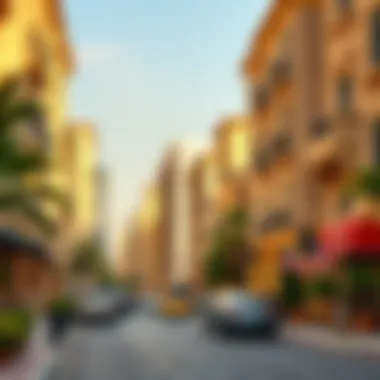
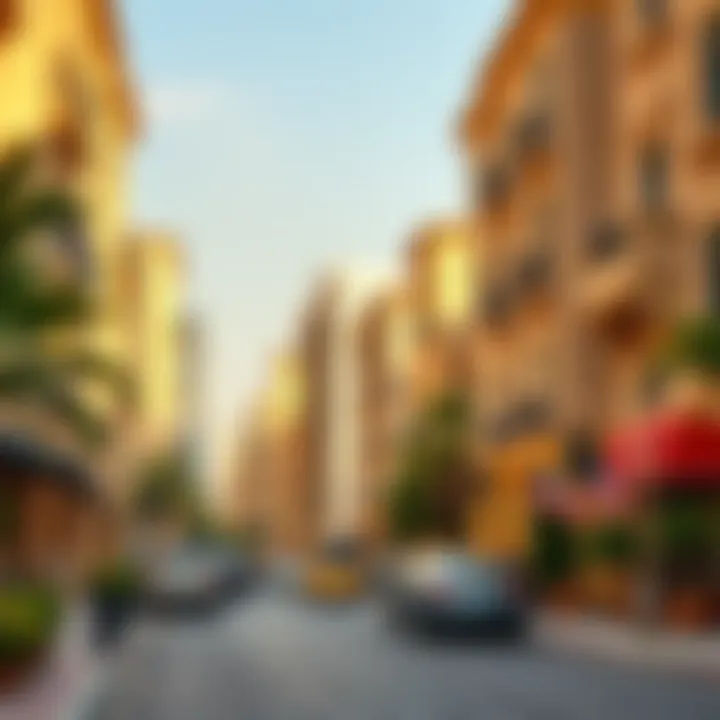
Cultural and community events in Dubai play a significant role in shaping the identity of its residential areas. They enrich the lives of residents and visitors, bringing vibrancy into the neighborhoods. These events serve as a bridge between diverse cultures, fostering camaraderie and understanding among various communities. Moreover, they offer unique opportunities for local businesses and artisans, contributing to the economic landscape.
Sounds intriguing, right? Let’s dive deeper into what makes these events so special.
Annual Festivals
Annual festivals in Dubai are a feast for the senses—celebrating everything from heritage to contemporary trends. These occasions attract both residents and tourists alike, weaving a rich tapestry of experiences throughout the year. Some notable festivals include the Dubai Shopping Festival, which turns the city into a shopper's paradise with endless sales and entertainment options. Then there's Eid Al Fitr, marking the end of Ramadan, when communities come together in joyful celebrations filled with food, music, and cultural performances.
Each event carries its own flavor, offering something different:
- Dubai Food Festival celebrates the local culinary scene.
- Art Dubai showcases creativity and innovation from local and international artists.
- Dubai International Film Festival highlights cinematic talent and storytelling.
These festivals don't just bring joy; they also enhance community bonds. Local performances often feature talent from the neighborhood, encouraging artistic expression and pride. Plus, businesses in the area get a nice boost during these festivities, making them a win-win for everyone.
Community Gatherings
Community gatherings in Dubai represent more than mere social interactions; they are vital for promoting a sense of belonging. Typically organized at local parks, community centers, or even residential complexes, these events vary in scope and scale. They can range from small get-togethers to larger, themed celebrations.
One exceptional event is the annual UAE National Day celebrations where everyone comes together to celebrate the country’s heritage.
- Cultural workshops
- Neighborhood clean-up drives
- Sports tournaments
These gatherings offer opportunities for residents to meet and connect with each other, fostering relationships that often extend beyond the duration of the events. They are a comfort zone for newcomers, where people can mingle and feel at home in their new surroundings.
Cost of Living and Property Market Analysis
Understanding the cost of living and the dynamics of the property market in Dubai provides a critical lens through which potential homeowners, visitors, and urban planners can gauge their expectations. With living expenses and property prices fluctuating, this section sheds light on pivotal trends and considerations that shape the residential experience in this vibrant city.
Real Estate Pricing Trends
The real estate market in Dubai has long been marked by its volatility, making the analysis of pricing trends essential for anyone considering a move. Recently, figures have shown a shift towards more stable pricing following a period of dramatic price surges and declines. As of late, key developments in areas like Dubai Marina and Downtown Dubai have influenced the general market sentiment.
Several factors contribute to these trends:
- Supply and Demand Dynamics: With an influx of expatriates and global investors, demand often outpaces supply, particularly for high-end properties.
- Government Initiatives: Programs aimed at attracting foreign investment, such as the 10-year visa for investors, have led to optimism and price stabilization in various neighborhoods.
- Economic Indicators: Fluctuations in oil prices and overall economic growth heavily impact market sentiment. A recovering economy tends to boost buyer confidence.
For instance, the prices of apartments in business hubs have seen a gradual increase, while villas in suburban spaces have proven more resilient to price drops. According to the property consultancy, Asteco, prices in some upscale areas have risen by 4% from last year, indicating a recovering market.
Investment Opportunities
Dubai's property market presents a wealth of investment opportunities, attracting both seasoned investors and newcomers looking to plant roots. Areas like Jumeirah and Business Bay offer attractive returns, particularly for those looking to invest in rental properties.
A few noteworthy opportunities include:
- Off-Plan Properties: Many developers are unveiling projects that allow investors to buy at lower prices, thereby reaping benefits once construction concludes.
- Short-term Rentals: The rising popularity of platforms like Airbnb is reshaping the rental market in Dubai, making it lucrative for investors to tap into the hospitality sector.
- Emerging Neighborhoods: Areas on the outskirts, such as Dubai South and Mohammed Bin Rashid City, are poised for growth, providing affordable options that could appreciate significantly over time.
"Investing in Dubai real estate can yield substantial returns, especially with the increasing global interest in the emirate as a hub for business and tourism."
Breaking down these opportunities further means considering the legal frameworks and financing options available for foreign investors. Dubai offers various financing plans with leading banks, making the transition to homeownership or investment smoother.
End and Future Outlook
As we draw this exploration to a close, it's evident that understanding the residential areas of Dubai is not just about examining bricks and mortar. It’s about grasping the vibrant tapestry of lives interwoven within these neighborhoods. The conclusion sheds light on why this topic holds significance, especially for those engaged in real estate, community planning, or simply considering a move to this magnificent city.
Sustainable Development Initiatives
Sustainability has become more than a buzzword in modern urban planning; it is a necessity. In Dubai, the push towards sustainable development is evident, with initiatives being integrated into residential projects throughout the city. The concept of smart cities is rising, where technology marries tradition to enhance the living experience without compromising environmental integrity.
New residential projects are often designed with energy efficiency in mind. Developers are focusing on using materials that are not just aesthetically pleasing but also environmentally friendly. For instance, the Al Furjan community has garnered attention for its commitment to sustainability, featuring abundant green spaces and pedestrian-friendly pathways. Residents often enjoy aspects like solar panels, water recycling systems, and parks that promote biodiversity—all contributing to a more sustainable lifestyle.
Moreover, community gardens and local agriculture are popping up in various neighborhoods, connecting urban life with nature. Such initiatives are crucial as they promote healthier living environments while encouraging community interaction.
Impact of Global Trends on Local Markets
Dubai does not exist in a vacuum. The influence of global trends on its local market is palpable. With shifts in demographics and the rise of digital nomadism, businesses and residences must adapt to meet evolving needs. The pandemic has reshaped lifestyles, prompting individuals to seek more spacious homes that provide a balance between work and life.
As remote work gains traction, areas such as Dubai Marina and Business Bay have become highly sought after for their flexible living conditions and ease of access to amenities. Furthermore, the growing interest in mixed-use developments offers an integration of residential, work, and leisure spaces that cater to modern living preferences.
Social consciousness has also found its way into property decisions. Homebuyers increasingly prioritize communities that align with their values. Aspects such as local culture, social equity, and environmental advocacy are now influencing purchasing power.
"A locality's appeal hinges on its ability to evolve with time, turning the challenges posed by global trends into opportunities for growth and innovation."
As the landscape of Dubai continues to shift, the insights provided in this article serve as critical navigation tools for homeowners, planners, and anyone interested in the essence of this dynamic city. By prioritizing sustainable initiatives and remaining responsive to global trends, the future of Dubai's residential areas appears promising, grounded in both innovation and tradition.
